Asia Pacific Cycling Conference Successfully Rebooted in Brisbane
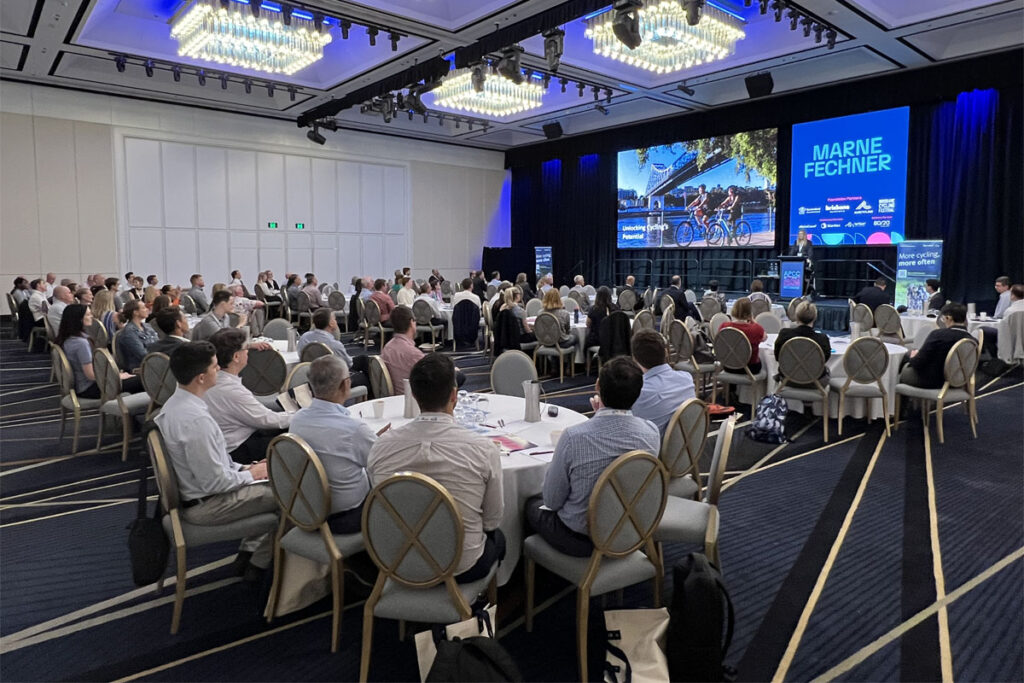
Brisbane, Qld
Way back in 2011, 2013 and 2015, what was then known as the Asia Pacific Cycle Congress was held in Brisbane, the Gold Coast and then back in Brisbane.
I remember participating in the Gold Coast edition and it was certainly a major event, helped by very significant financial backing from the Queensland government. Unfortunately, due to a range of circumstances, that conference was only held once subsequent to 2015 – from memory that was in New Zealand, and then it ceased.
Fast forward to 2023 and Aaron Flannagan, of 80/20 Partners decided he’s like to revive the conference, with a slight tweak in the name, to become the Asia Pacific Cycling Conference.
Aaron is Director of 80/20 which is a Sunshine Coast-based diversified events company. One of their main events is staging the Brisbane Cycling Festival, which they’ve directed on behalf of AusCycling since 2019.
The Asia Pacific Cycling Conference was held as a part of this year’s Brisbane Cycling Festival, although the conference venue, the Sofitel Brisbane Central, was about two kilometres away from the Brisbane Cycling Festival hub at the Brisbane Showgrounds.
Considering the entire event was pulled together from scratch in little more than six months, it ran very smoothly, with a packed two day lineup of high-calibre speakers and an enthusiastic audience of about 80 in the room at any given time, although more individuals attended in total, with some being day one or day two only attendees.
Renowned cycling commentator Matt Keenan did a great job throughout the conference as emcee, often injecting some much needed humour between sessions where stark details of how far Australia is lagging behind leading countries could be, quite frankly, depressing!
In this article I’ll touch very briefly on highlights from most of the presentations and look at some common threads.
An Olympic-Sized Opportunity
For the south-east Queensland-based speakers in particular, the 2032 Brisbane Olympic Games is already looming large on their radar.
Apparently as part of their successful bid contract with the International Olympic Committee (IOC), the Brisbane Olympics must be “Climate Positive”, which means going a step further than just “carbon neutral”.
With the ground transportation of athletes, officials and spectators being a huge component of the Olympics and the vast logistical scale required, this should give major opportunities for expansion of active transport including walking, scooting and cycling, plus integration with an expanded public transport network.
As several speakers stressed, although 2032 might sound like a long way off, it’s only eight years away. Given the long lead times that government infrastructure projects, such as new bicycle paths, can take to be planned, funded and built, the window of opportunity to make proactive investments is only open for the next few years.
Day One
Bart Mellish
Bart Mellish, Queensland Minister for Transport and Main Roads officially opened the conference saying, “I will reconfirm our government’s commitment to cycling.”
Measured in dollars, he said that this commitment will be $300 million between now and 2027 on stand-alone active transport infrastructure. He didn’t mention that this amount is only about 1% of what his government plans to spend on roads for motor vehicles during this time.
He also didn’t mention that on 26th October this year there will be a state election and that the current state Labor government of which he is a part is lagging in the polls, behind the Liberal National Party. Of course, if there’s a change of government then all previous commitments are up for review.
Marne Fechner
Next to present was Marnie Fechner, CEO of AusCycling. This is the organisation that oversees all aspects of cycle sport, so as you might expect, her presentation had a sporting flavour.
But she also spoke about their Ausbike bike education program for kids aged 5-12 years which has trained 20,000 school students across 35 locations since it was launched last year.
“AusCycling’s membership is very male, pale and stale,” she frankly admitted. “If you engage with kids between 5-10 years old they’re 15-20 times more likely to engage with that sport later in life.”
Continuing the Olympic them, Marne finished by saying, “Imagine if we collectively had an audacious goal to make Brisbane the world’s most cycling friendly city before the 2032 Brisbane Olympics.”
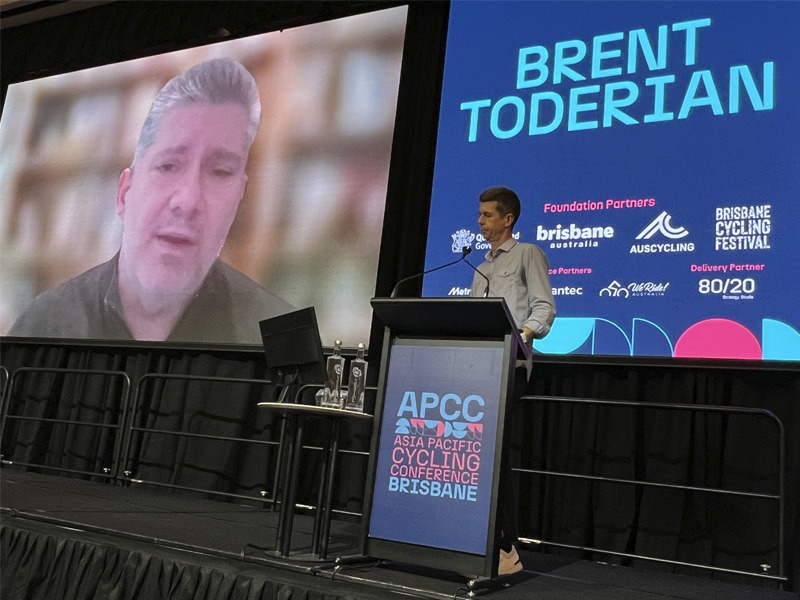
Brent Toderian
Renowned Canadian consultant Brent Toderian was the virtual keynote speaker, looming large on the giant screen from his home in Vancouver.
After a career within the City of Vancouver government, he now consults to cities around the world, including several in Australia.
He bemoaned how active trouble had become a political battleground saying, “This isn’t right or left, it’s smart or dumb! Urban biking is a means to an end. Cities function better when urban biking functions better – not only for the people who are riding bikes. Urban biking makes cities cheaper and safer.”
In referring how to counter popularist media push back, he said, “The way you win the argument more effectively is through a combination of better data and better storytelling. Don’t make it about cars vs bikes… you’ll lose! We are really bad at this. We make it easy for talkback radio to kick the crap out of us.”
Alexander Paz
Alexander Paz is Professor and Transport and Main Roads Chair at the School of Civil & Environmental Engineering at Queensland University of Technology.
He said that in Southeast Queensland (that includes the Sunshine Coast, Brisbane and the Gold Coast) the current mode share is 5% for active transport (which includes cycling and walking), 6% public transport and 89% cars and other motor vehicles, making it one of the most car dominated places in the world.

Sam Johnson
Sam is Sustainable Transport Specialist and co-lead of the Active Mobility Knowledge Group at the World Bank.
The World Bank was established shortly after the end of World War Two. Almost all the world’s countries are members. It invests over US$300 billion (A$462 billion), mainly in projects to assist developing countries.
Sam brought an important “Asia Pacific” element to the conference by sharing case studies from Beijing and Tianjin in China.
He said that China, while famously being a cycling nation for most of the 20th century, rapidly adopted motor vehicles in the latter part of that century, resulting in massive congestion, choking air pollution and a reduced quality of life. Before that point, until as late as the mid 1980’s, bicycling accounted for around half of all trips in major cities across China.
Beijing has roughly Australia’s entire population in a single, highly densely populated greater urban area, so the government finally realised that a single occupant car commuter model is not sustainable. What happened next was a dramatic pivot, that he said started with rising awareness of the problem from 2005 to 2011, followed by change on the ground, which has accelerated since 2020.
Sam described some of the key elements of this change.
Firstly, China has far more bike share bikes than any other nation on earth. In 2021 the total fleet was 955,000 bikes doing 950 million rides per year, or roughly 1,000 rides per bike per year. Bikeshare is a closely integrated element of the public transport network. 70% of these rides link with public transportation.
The Beijing MaaS (Mobility as a Service) app has 24 million registered users and rewards those who use the share bikes.
Secondly, China has created a Walking & Biking Citywide Development Management Tool, that systemises and accelerates the process and is being adopted across many Chinese cities.
Thirdly they’ve boldly reallocated large amounts of road space to bicycles, installing very wide, protected bike lanes.
Sam also spoke briefly about Singapore, which is looking to retrofit a “massive” bike network of 1,300 km by 2030. This will more than double Singapore’s existing bike network.
The True Measure of Cycling Infrastructure Development
This was the title of a panel discussion that rounded out the first morning, hosted by Susanne Bransgrove, co-founder of Bikey Wipes and featuring John Symons from Victoria University, Sandy Murdoch from Traction and Ishara Sahama from the Echo Impact Group.
Traction is a community based not-for-profit that mentors young people. Sandy spoke about a program in which, starting from a bare frame they paint and build a bicycle which they get to keep at the end of the program. He said, “Bicycles are a powerful vehicle for bringing people together.” He described Australia’s contemporary landscape as suffering from, “an epidemic of isolation.”
Sarah Davies
Sarah kicked off the afternoon session with an update from the day one conference sponsor Metro Count, where she is Projects Manager.
Metro Count is based in Fremantle, WA, but also has offices and client in multiple countries worldwide. She showed various examples of both temporary and long term installations of counting systems, both within Australia and elsewhere and said that they are currently working with the University of Western Australia on video based systems that will use AI (artificial intelligence) to analyse the images.
Chris Petit
Professor Chris Petit is the Director of the City Futures Research Centre and inaugural professor of Urban Science at the University of NSW in Sydney.
He showed images of a virtual reality simulator they’ve developed so that they can safely see how “interested but concerned” potential new riders react to a range of traffic situations.
The system measures their stress via skin sensors, head and eye tracking and pre and post experiment surveys.
He said one of their key learnings so far is that people feel comfortable on separated bike lanes but not on “quiet ways” which are traffic calmed roads where cyclists and motorists share the same space.
Narelle Haworth
Professor Narelle Haworth is a Research Professor at CARRS-Q (the Centre for Accident Research and Road Safety-Queensland). She’s commencing a new federally funded study of all forms of cycling clothing, looking at how protective it is for the rider.
Turning to road safety she said that there’s a difference between visibility and conspicuity. Visibility relates to the question, “Can you be seen?”. But conspicuity asks, “Are people actually seeing you?”
The answers to these two questions can be completely different in many situations, which leads to pedestrians and people riding bikes being hit by motorists in broad daylight who, “didn’t see them.”
“You see what you expect to see,” she said. “When there are low numbers of cyclists, motorists are not expecting to see bikes.”
Richard Bunning
Next the conference turned its attention to cycle tourism. Richard Bunning is a Senior Lecturer at the University of Queensland Business School, who specialises in tourism. He’s also a director of Bicycle Queensland.
Looking at bike and scooter share, he said that one third of the riders of Brisbane’s highly popular share schemes are cycle tourists. He said that tourists spend more time and money on the share devices than locals. Tourists go on longer rides and often say that their bike and scooter share experiences are a highlight of their visit.
He also spoke about dispersal of tourists so that more businesses across a wider geographic area benefit from the money that they spend. He said that the share bikes and scooters are a vital link that enables this to happen.
Stephen Hodge and Megan Paybody
Stephen Hodge from We Ride Australia and Megan Paybody from EY shared the findings of the most recent Cycling and E-Scooter Economy Report.
Megan said this report was based upon the largest and most detailed survey ever conducted in Australia in relation to these topics.
Here’s a snapshot of some of the report’s key findings.
The estimated total benefits of cycling and e-scooters for calendar year 2022 was $18.6 billion. 6.5 million adults cycled and 3.6 million adults used an e-scooter.
In total they saved 514,096 tonnes of Co2 emissions.
Turning to direct spending, the biggest single category was bike related purchases, which includes all forms of parts & accessories, bike repairs etc at $2.236 billion, followed by cycle tourism at $1.885 billion and sales of complete bicycles at $1.785 billion.
They found that the number one motivating factor for people riding was physical fitness, followed in order by mental wellbeing, fun, environmental considerations, exploring new places, a convenient mode of transportation, saving money, social connections, sport and racing.
Meanwhile the number one deterrent that people said stopped them from cycling was the weather, followed by six different safety related reasons, then bike parking.
Alton Twine
As we recently reported here, Alton Twine recently left a long, senior career in state and local government to become CEO of the advocacy group Bicycle Queensland, which currently has 13,000 members.
His presentation focused upon the importance of local links in a bicycle network.
“If you want to get more people riding bikes, build the local network,” he said.
Alton used the outer suburb of Ormeau as an example. This suburb, located half way between Brisbane and the Gold Coast, is a classic example of the abysmal urban planning that is deemed acceptable right now in every Australian city. The suburb is dissected by the M1 motorway, an eight lane, 110 kph barrier. There are no active travel bridges or underpasses at all, and “planners” thoughtfully allowed the high school to be built on the opposite side of the motorway to the main residential area.
One of the consequences is 45 minute twice daily traffic jams at the only road bridge over the motorway. An of course, hardly any kids walking or cycling to school.
Using maps and diagrams, he demonstrated how building a few key missing links could make significant improvements, even to this sprawling, car-centric, underserved exurb.
Day Two
Ryan Murphy
Ryan is a councillor in the Brisbane City Council and the Cabinet Chair for Transport.
Unlike most other Australian cities where the urban area is divided into many small local government areas, greater urban Brisbane has just four local governments of which Brisbane City Council is by far the largest, both in terms of population and budget. It’s the most populous local government in Australia with 1,242,825 residents in 2021 which was just a fraction less than our three least populous states and territories combined (ACT, Northern Territory and Tasmania).
“This year, Brisbane City Council will invest more in active transport and the Queensland Government,” Cr Murphy said.
In particular he highlighted the Kangaroo Point Green Bridge, scheduled to open later this year at a cost of $190 million.
“Our modelling is predicting that 6,200 cyclists and pedestrians will use this bridge daily,” he said. “And our modelling is conservative. Before the Breakfast Creek Green Bridge was built, we predicted 1,200 users per day and the actual data is already up to 2,600 per day.”
He was referring to a recently opened separated pathway and bridge a few kilometres further downstream along the Brisbane River, which was constructed at the point where Breakfast Creek flows into the river.
“The total number of people riding into the CBD has more than doubled in the past 15 years,” he reported.
Cr Murphy then turned his attention to bike and scooter share. “In 2018, we were one of the first cities to introduce shared e-bikes and e-scooters. Since then there have been 14 million trips. E-mobility will soon quadruple the number of people riding into the city.
“E-mobility actually subsidises the Council, which allows us to re-invest funds into infrastructure. With the new share scheme contracts commencing in 2024 we will be spending $1 million on e-bike and e-scooter parking.”
Penny Ford
Penny is the General Manager (Transport Strategy & Planning) for TMR (the Queensland Department of Transport and Main Roads).
She began with a promotional video which highlighted some new projects and then explained that they’re following their published Queensland Cycling Strategy 2017-27 which is then updated with two year Action Plans and yearly Annual Reports on progress.
Ms Ford said that $328 million will be spent over the next four years on their Active Transport Program. Only 57 km of their Principal Cycle Network was built in the five years from 2016 to 2021 but 158 km is planned in the period from 2023 to 2027. A lot of this is part of road upgrades.
Recently rules have been changed to allow bicycles on trains at any time of day.
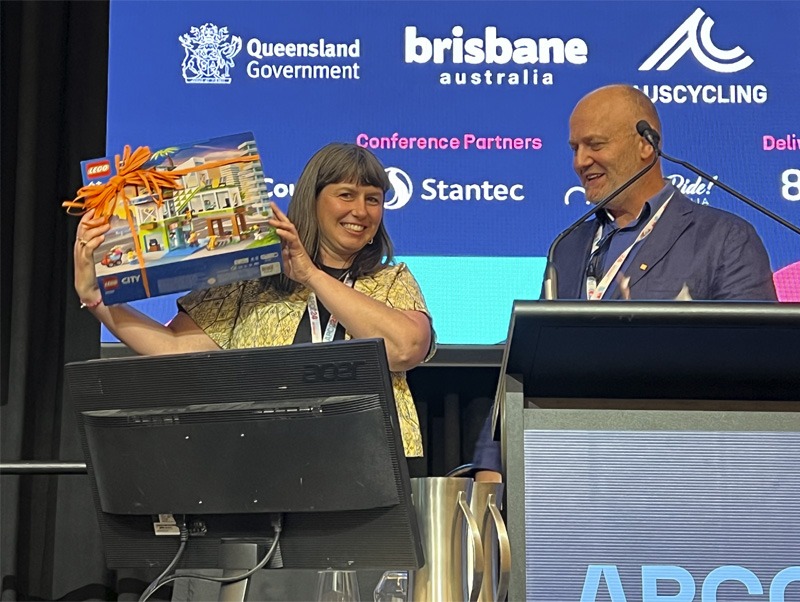
James Lang
This presentation kicked off with a difference, a lucky dip prize draw to win a Lego City box set.
James, who is Transportation Practice Leader – Cycle Planning & Design at Stantec, turned the focus from Brisbane southwards to his hometown of Melbourne.
He showed photos of the Heidelberg Road separated bike path, which is still a “temporary” facility that was only introduced during the covid lockdowns. As we previously reported here, when it was introduced, the usual tabloid and shock jock suspects loudly complained. But three years on, the paths are still in place and James is hoping they will be made permanent.
“We’re doing the right thing,” James said. “There will be a tipping point and we’re on the right side of history.”
He also noted that Victoria now has a Minister for Public and Active Transport, a portfolio that did not exist until recently. This portfolio is currently held by the Hon. Gabrielle Williams.

Nick Morris
Nick Morris used a lift to reach the stage. He shared his story that at age 16 he was involved in a motorcycle crash that left him paralysed. But that hasn’t stopped him living a full life including being a paralypian, getting married and having a family.
Nick now advises a wide range of governments and other organisations on the finer details of accessibility.
He said that 30%-40% of Australians have some sort of accessibility need – a figure that has been growing due to our ageing population. These needs aren’t just related to those in wheelchairs, but everything from blindness to deafness to people who struggle with stairs.
He said that the accessible tourism market was worth $13.5 billion per year and that 1 million domestic trips – 19% of the total, involved someone with an accessibility need.
Kate Veronneau
Kate gave her presentation from the USA via Zoom. She is the Director of Women’s strategy at Zwift (an online training system). A former professional cyclist, she was a driving force behind the relaunch after a long absence of the women’s Tour de France, now known as the Tour de France Femmes avec Zwift.
She gave data about the event’s huge global viewing audience and explained how vital the Tour is for the viability of the women’s professional cycling season.
In men’s cycling about 80% to 90% of the media value that pro teams receive in their entire season is via the Tour de France.
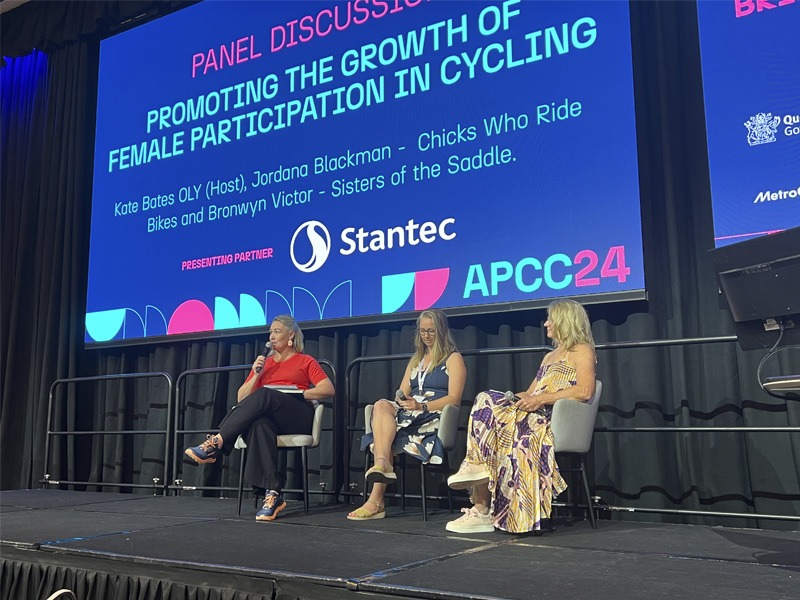
Kate Bates, Jordana Blackman and Bronwyn Victor
Rolling on from this was a panel session to discuss, “Promoting the Growth of Women’s Cycling.”
Former Olympic cyclist Kate Bates hosted the panel, joined by Jordana Blackman, founder of Chicks who Ride Bikes and Bronwyn Victor, co-founder of Sisters of the Saddle.
Bronwyn was also previously co-owner of leading Brisbane shop Planet Bikes and said that a key to their retail success was, “Make the women feel welcome and the men will come.”
Sisters of the Saddle runs women-only charity rides that have raised $650,000 over the past two years.
Meanwhile Jordana from Chicks who Ride Bikes said she likes nothing more than introducing new women to cycling. She said they need a safe place to ask simple questions such as what to do if they have a flat tyre.
Craig Meinicke
Next the conference went off road with trail designer, builder and consultant Craig Meinicke who is founder of Blue Sky Trails.
He spoke at length about the importance of good data both to justify funding decisions and for better trail management. With this in mind, he has developed trail management software called Trail Vision.
Craig also shared data on the relatively new Northern Rivers Rail Trail, which is in far northeastern NSW. We have previously written extensively about this important new trail including development milestones here and it’s opening here.
Despite only a small fraction of its potential total length being opened so far, the trail is already attracting 14,085 visitors per month, which is 459 per day and has 267 Google reviews at an average 4.8 star rating.
Further detailed counting showed that 53% of all users were riding analogue bikes, 29% e-bikes, 18% walking and the rest horse riding. The most popular visit day was Sunday, followed by Saturday, Friday, Wednesday, Thursday, Tuesday and Monday. The most popular time to visit was 9am-11am.
John MacArthur
After lunch we had another international speaker, but this time, in person. John is the Sustainable Transportation Manager at Portland State University.
He spoke about “Moving the Market for E-Bikes”. He reported on the growth of e-bike purchase subsidy schemes across the USA.
John said that one of the best known schemes, in Denver, Colorado last year distributed US$7,500,000 (A$11,550,000) and 7,500 vouchers were redeemed, meaning that the average subsidy was US$1,000 (A$1,540) per bike.
The vouchers were redeemed through 30 local brick and mortar bike shops. Mail order retailers were not allowed to participate. Surveys of voucher recipients showed that standard rebate recipients were on average riding 31 kilometres per week and income qualified rebate recipients (ie those on lower income who received a higher value voucher) were riding 51 kilometres per week.
71% of recipients said they were using their car less often and 29% were new to cycling.
Vida Christeller
Vida came to the conference from Wellington New Zealand where she is the City Design Manager at Wellington City Council. New Zealand’s capital city is at the centre of a greater urban area totalling a little over half a million residents.
Vida told the story of how she moved back to NZ after years living in Copenhagen, Denmark. In Wellington, Vida is in charge of the team responsible for implementing a historic increase in funding for bicycle infrastructure.
The program has met with small pockets of very strong and sometimes even aggressive opposition.
“Cycleways are sponges for all of our community’s anxieties,” she said.
Her presentation centred upon how her team were able to win the trust of the community through their ability, integrity and benevolence. She also spoke about her concerted effort to protect the mental health of her team during times of strong pushback, including at least two legal challenges.
Peter Bouke
Peter was introduced as the CEO of We Ride Australia but stressed that he was making his presentation in his second part time role, CEO of BIA (Bicycle Industries Australia).
He spoke about the challenges to the industry of e-bike fires and inconsistent regulations around Australia in relation to e-bike specifications.
Peter showed a very interesting list of all the e-bike brands that had been involved in known fires during 2023. Not a single major bike brand that is sold via dealers was on the list, which was full of cheaper brands and direct imports.
But the dealers are still paying the price for the reckless behaviour of others. He said that typical bike shop insurance premiums have risen by about 250% for those selling e-bikes.

Matthew Burke
Professor Matthew Burke is from Griffith University in Brisbane where he is Deputy Director of the Cities Research Institute. He also holds senior advisory roles for both TMR and Brisbane City Council.
He gave an animated review of how cars are literally taking over schools in Brisbane. In stark contrast to cities like Paris that is closing hundreds of roads in front of schools as part of their “School Streets” program, the opposite is happening in Brisbane.
Schools are being required to reallocate huge amounts of their school land to allow cars onto their properties.
In one case a double laned road snaked right through their playing fields, to allow more “storage” of cars waiting to drop off children each morning and pick them up each afternoon.
He said that part of the problem is the huge distances that students often have to travel to school. Even primary schools have 2,000 or more students, because it’s cheaper for the government to run fewer, larger schools, than many smaller local schools, which would also allow for more students to live within a walkable or rideable distance.
He said that the situation is even worse for high schools, which have up to 4,000 students in a single school. Another factor was the increasing percentage of Australian students who attend private schools. He said that we have one of the highest percentages of private schooling in the world. These schools are often huge distances from the students’ homes.

Irene McAleese
Irene is the co-founder of See.Sense that uses sophisticated sensory hardware and software, currently mounted within bicycle taillights, to build detailed databases of the cities they’re consulting with. These reveal everything from near misses to road surface irregularities plus a host of other valuable data.
As the final speaker for the conference, Irene summarised some of the conference highlights and also added a chilling statistic that had not been mentioned at all previously.
In the 12 months to September 2023, 43 cyclists were killed on Australian roads. This was a 33% increase compared to the previous 12 months and the biggest single increase of any road user group.
On a more hopeful note, she quoted a recent McKinsey Report into the future of micromobility which concluded, “Within the next decade, the mobility ecosystem will undergo a transformation not seen since the early days of the automobile – and one main shift will be the decline of private car use.”
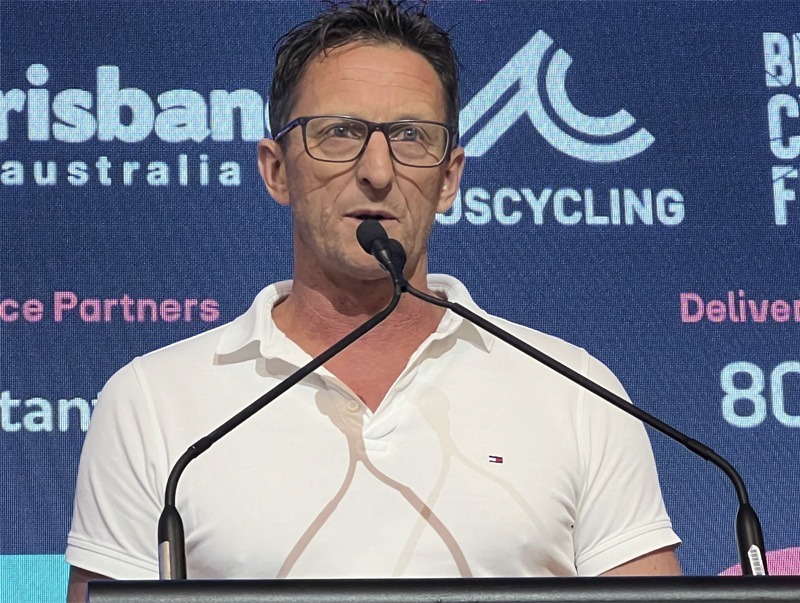
It was a fitting note on which to wrap up an excellent conference. Organiser Aaron Flanagan said that he expects the Asia Pacific Cycling Conference to be held annually for the next two years.

Thanks for this detailed report Phil.